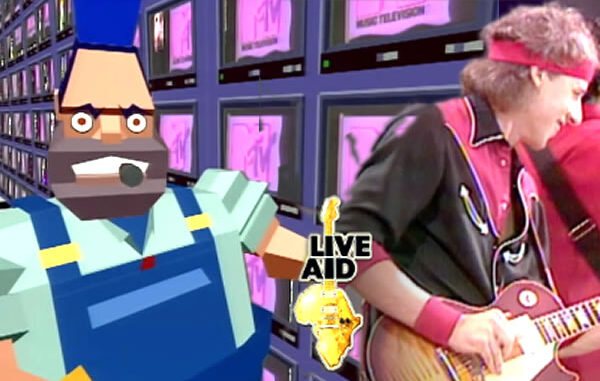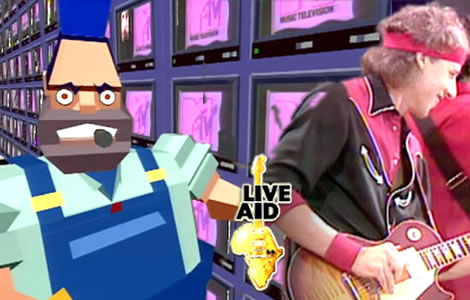
Dire Straits, the British rock band fronted by Mark Knopfler, achieved significant commercial success and critical acclaim with their 1985 hit “Money for Nothing.”

Featured on their fifth studio album, “Brothers in Arms,” the song not only became one of the band’s most well-known tracks but also left an indelible mark on the music video landscape, emblematic of the MTV era and the burgeoning digital age.
The Song: A Critique of Consumer Culture
“Money for Nothing” is a satirical commentary on the rock and roll lifestyle and the materialistic culture prevalent in the United States during the 1980s, a period often characterized by rampant consumerism and the influence of the Reagan administration’s economic policies. The song’s lyrics were inspired by a conversation Mark Knopfler overheard in an appliance store, where a delivery man was watching music videos and commenting on the perceived ease and lavishness of rock stars’ lives.
The lyrics, narrated from the perspective of a working-class man, express envy and disdain towards rock stars, highlighting the disparity between their luxurious lifestyles and the everyday struggles of blue-collar workers. Lines such as “That ain’t workin’, that’s the way you do it, money for nothin’ and your chicks for free” encapsulate this sentiment, making the song both a humorous and pointed critique of the excesses of fame and wealth.
The Music Video: A Technological Milestone
The music video for “Money for Nothing” became an iconic representation of the MTV generation. Directed by Steve Barron, the video was groundbreaking for its time due to its innovative use of computer-generated imagery (CGI). It featured blocky, cartoonish characters and a crude animation style that, while primitive by today’s standards, was cutting-edge in the mid-1980s.
The video begins with a delivery man (resembling the character from the song’s lyrics) watching Dire Straits on television. The animation sequences are interspersed with footage of the band performing, creating a juxtaposition between the animated world and the real one. This blend of CGI and live-action was novel and visually captivating, aligning perfectly with MTV’s ethos of pushing the boundaries of what a music video could be.
MTV and the Video Age
MTV launched in 1981, revolutionised the music industry by providing a platform where music videos became as important as the songs themselves. “Money for Nothing” was a perfect fit for MTV, both in terms of its lyrical content and its innovative video. The network’s heavy rotation of the video helped propel the song to number one on the Billboard Hot 100, cementing Dire Straits’ place in music history.
The video’s emphasis on the visual element of music consumption was a harbinger of the digital age to come, where visuals and multimedia would become integral to entertainment and communication. The animated sequences, while simplistic, hinted at the future potential of digital graphics and animation, foreshadowing the technological advancements that would eventually lead to the internet and modern digital media.
Cultural Impact and Criticism
“Money for Nothing” resonated with audiences not only for its catchy riff and memorable lyrics but also for its reflection of the era’s cultural and economic landscape.
The song’s portrayal of consumerism and materialism struck a chord in the mid-1980s, a time marked by economic growth and the rise of corporate culture under President Ronald Reagan’s administration. The era’s ethos of success and wealth accumulation is encapsulated in the song’s ironic take on the rock star lifestyle.
However, the song and its video were not without controversy. The lyrics, specifically the use of a homophobic slur, drew criticism for being offensive. In subsequent years, the band and Knopfler have acknowledged the problematic nature of the lyrics, and some radio stations have opted to play edited versions of the song. This aspect of the song serves as a reminder of how cultural sensitivities evolve over time and the importance of reflecting on and addressing past prejudices.
Legacy of “Money for Nothing”
“Money for Nothing” remains a significant track in Dire Straits’ catalogue and a touchstone of 1980s music culture. Its success helped “Brothers in Arms” become one of the best-selling albums of the decade, with over 30 million copies sold worldwide. The song’s distinctive guitar riff, created with the help of a Gibson Les Paul and a unique amplifier setup, remains one of rock music’s most recognizable sounds.
The music video for “Money for Nothing” is often cited as one of the greatest and most influential music videos of all time. It set a precedent for the use of computer animation in music videos and opened the door for future innovations in the medium. Its success on MTV demonstrated the power of visual media in shaping musical success and highlighted the growing importance of multimedia in the entertainment industry.
Capitol fm adult rock power play, a cultural memory
Dire Straits’ “Money for Nothing” is more than just a hit song; it is a cultural artefact that captures the spirit of the 1980s, reflecting both the era’s technological advancements and its social dynamics. The song’s critique of consumerism and the excesses of fame, coupled with its groundbreaking music video, ensure its place in music history as a milestone of the MTV generation and a precursor to the digital age.
